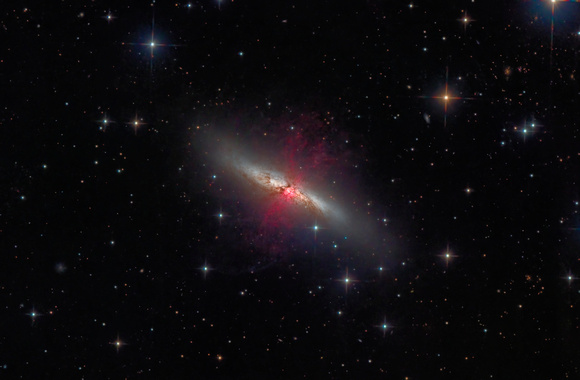M82 - The Cigar Galaxy in LHaRGB
M82 in LHaRGB (Ursa Major) , May 17,18,19 & 24 2023
Planewave CDK12.5" telecope and A-P 1100GTO AE mount
ASI6200MM Camera, Antlia Pro BB & 3nm Ha Filters
Lum (37 x 200s exposures, Bin 2x2, Gain 100)
R,G,B (20,24,25 x 240s exposures, Bin 2x2 Gain 100)
Ha (23 x 400s exposures, Bin 2x2, Gain200)
Total Integration Time = 9.2 hours
M82, The Cigar Galaxy, is quite the hotbed of star formation, as noted by the red H2 emissions combing out of the galactic plane. The statistics are quite impressive, with the equivalent of a sun-like star being created every year here - a rate that is ten times faster than all of the star forming regions in the Milky Way, despite being 20% smaller.
The whole rapid star formation process is believed to have been triggered by a relatively close encounter with M82 (Bodes Galaxy) when tidal forces distorted M81 some 200 to 500 million years ago when it was a quiet galaxy minding its own business. The gravity forces gave the pot a stir, as it were, creating what we call a "Starburst" galaxy. (Another, less dramatic starburst galaxy, can be seen in images of M106, where two extra spiral arms of H2 emitting regions seem to leave the galactic plane.) Initially, M82 was thought to be an "irregular" shaped galaxy, but infrared data has shown that it is indeed a spiral. With some imagination, spirals can be made out here, but the abundance of new stars makes the galaxy so bright that it largely obscures its structure. As a result of all those new stars, M82 is very bright, about five times brighter than the Milky Way and its core is 100 times moreso.
An abundance of new stars (especially fast burning, large blue ones) also results in an abundance of supernova, the last one recorded in 2014, after several were noted in the previous decades. These supernovae dramatically increase the solar winds that help push molecular clouds away from their regular "dust lane" positions. Other than that, the clouds march through their cycles of collapse to create stars, followed by being blown apart by those same stars.
The molecular clouds that create those stars is also being used at a very high rate in M82. In a few tens of millions of years, star formation will slow as the material becomes used up and more disperse.
M82 is also notable as it contains the brightest pulsar yet discovered - M82 X-2. M82 lies 12 million ly away from us, yet only 300,000 light years from M81 (with big error bars).
The Cigar shape may be a result of M82 continuously celebrating the birth of so many new stars.


